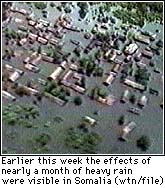 than three decades to Somalia, wracking the
country and its people that already had more than their share
of civil wars and recurring droughts said by SEPADO, Somalia Environmental Protection and
Anti Desertification Organization.
than three decades to Somalia, wracking the
country and its people that already had more than their share
of civil wars and recurring droughts said by SEPADO, Somalia Environmental Protection and
Anti Desertification Organization. Nearly twenty days of torrential rains
have brought the worst flooding in more  than three decades to Somalia, wracking the
country and its people that already had more than their share
of civil wars and recurring droughts said by SEPADO, Somalia Environmental Protection and
Anti Desertification Organization.
than three decades to Somalia, wracking the
country and its people that already had more than their share
of civil wars and recurring droughts said by SEPADO, Somalia Environmental Protection and
Anti Desertification Organization.
These type of rains with such high magnitude of destruction and floods are the worst we have seen in the region since 1960, causing the death of over thousand people and wiped out tens of thousands of livestock, farms and villages. Some of the villages are completely under water. When you fly over the region, all you can see are the tips of the roofs.
Due The absence of government, only
few places have been visited and the rest of the country is beyond reach and can't be
accessed, thus the major problems is that nobody knows the actual effect of these
flooding.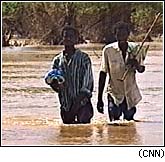
The few International agencies that operate in Somalia region are doing well in evacuating and distributing food and blankets to the needy people, however due to the large scale of the problem, Nomadic nature of Somalis and absence of transport for such situation like helicopters, air canoes etc. most of the affected areas have not been attended to.
Thousands of people have been affected. Many have lost their
homes and their crops and are now displaced. These rains were preceded by a major drought,
and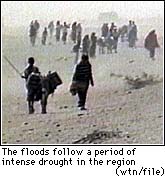 the combination of the two weather events could have a disastrous
impact on a rural population which was already fragile.
the combination of the two weather events could have a disastrous
impact on a rural population which was already fragile.
The rains, which are believed to have
been caused by the weather phenomenon El Nino,
have caused the Juba & Shabelle Rivers to burst their banks in several locations.
Every year, extreme climatic problems occur around the globe, with droughts in some places
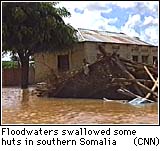 and floods in others. Recently, we have come to recognize that some of these
widely dispersed climatic extremes might have a common origin
in the occasional warming of sea surface water in the central and eastern equatorial
Pacific Ocean and Indian Ocean. These changes are known as EL NINO.
and floods in others. Recently, we have come to recognize that some of these
widely dispersed climatic extremes might have a common origin
in the occasional warming of sea surface water in the central and eastern equatorial
Pacific Ocean and Indian Ocean. These changes are known as EL NINO.
It is estimated that over 1000 persons have died and that about 1,000,000 are directly affected. People have taken shelter on small islets, others are clinging to tree branches while the rains are still falling in the area. Food stocks usually stored underground, are devastated and livestock have perished.
Access is rendered very difficult as roads are flooded, bridges
are underwater or washed away, and only 2 airstrips are open in more than four flooded
regions. The flooding is estimated to be the worst since 1961, and in the Juba &
Shabelle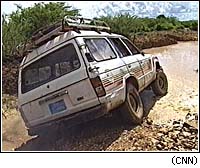 rivers area has spread hundreds of kilometers wide.
rivers area has spread hundreds of kilometers wide.
Initial surveys indicated that floods have destroyed the homes and the irrigated crops of thousands of families as well as washed away many roads, trapping people in the vicinity of their flooded villages.
SEPADO, Closely monitoring the international meteorological data and forecasting obtained from FEWS "Famine Early Warning System, USA based Meteorological center" believes it will continue to rain for ten more days, causing more floods and risking the lives and homes of many.
SEPADO, appeals to all gulf countries, Charity organizations, Somalis and Expats Communities to come to the rescue of these poor displaced people.